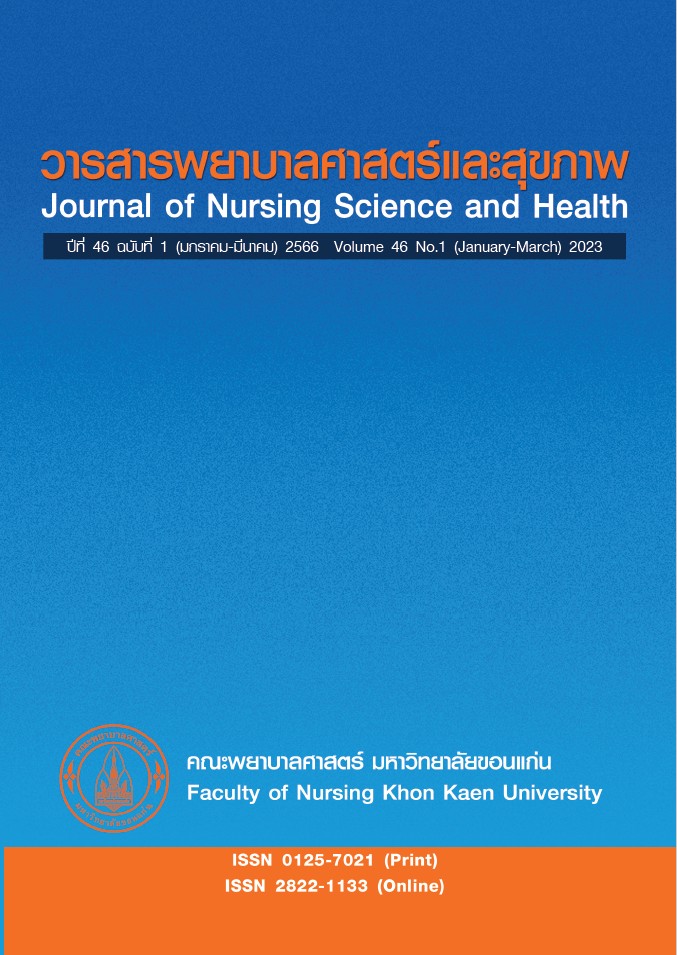การส่งเสริมความรอบรู้ด้านสุขภาพของวัยทำงานเพื่อป้องกัน โรคไม่ติดต่อเรื้อรัง : บทบาทพยาบาลสุขภาพชุมชน
คำสำคัญ:
ความรอบรู้ด้านสุขภาพ , บทบาทพยาบาล , พยาบาลสุขภาพชุมชน , โรคไม่ติดต่อเรื้อรังบทคัดย่อ
กลุ่มวัยทำงานเป็นกลุ่มประชากรที่มีความสำคัญการขับเคลื่อนองค์กรและการพัฒนาประเทศ โดยวัยทำงานจะเริ่มต้นตั้งแต่อายุมากกว่า 15 ปีขึ้นไปจนถึงวัยเกษียณอายุเนื่องจากประเทศไทยมีการจ้างงานหลังวัยเกษียณ อายุและพฤติกรรมสุขภาพเป็นปัจจัยเหตุของภาวะสุขภาพของคนกลุ่มวัยทำงาน ในศาสตร์การป้องกันการเบี่ยงเบนทางสุขภาพมีความเชื่อว่าการเจ็บป่วยด้วยโรคไม่ติดต่อเรื้อรังสามารถป้องกันได้หากบุคคลมีความรู้ ทักษะและพฤติกรรมสุขภาพที่เหมาะสม การได้รับการส่งเสริมความรอบรู้ด้านสุขภาพที่ถูกต้องจึงมีความสำคัญ จากการทบทวนวรรณกรรมพบว่า ความรอบรู้ด้านสุขภาพมีประสิทธิภาพในการป้องกันภาวะเบี่ยงเบนทางสุขภาพ ความรอบรู้ด้านสุขภาพจะช่วยให้บุคคลปฏิบัติพฤติกรรมที่เหมาะสมในด้าน การรับประทานอาหาร การออกกำลังกาย การจัดการความเครียดและความรับผิดชอบต่อสุขภาพตนเอง บทความนี้จึงมีวัตถุประสงค์เพื่อเสนอแนวทางการส่งเสริมความรอบรู้ด้านสุขภาพของ วัยทำงานในการป้องกันโรคไม่ติดต่อเรื้อรัง โดยผู้เขียนมุ่งหวังว่าจะเป็นประโยชน์ต่อการพัฒนาความรู้ของพยาบาลและสหสาขาวิชาชีพที่จะนำความรู้ในบทความนี้ไปประยุกต์ใช้ในการการส่งเสริมความรอบรู้ด้านสุขภาพแก่คนกลุ่มวัยทำงานเพื่อป้องกันโรคไม่ติดต่อเรื้อรังต่อไป
เอกสารอ้างอิง
Sarker S, Arifuzzaman K, Rezwan M. Working age population and economic growth in bangladesh: A time-series approach. International Multidisciplinary Conference on Sustainable Development (IMCSD); 2016.
Kanjanapibulwong A, Khamwangsanga P, Kaewtha S. NCDs situation report: Diabetes, high blood pressure and related risk factors 2019. Technology, epidemiology and community measures division of non-communicable diseases department of disease control, ministry of public health, Graphic and Design typography; 2020. (in Thai)
World Health Organization. Global status report on noncommunicable diseases. [Internet]. Geneva, Switzerland. 2014. [cited 2021 Nov 15]. Available from: http://www.who.int/nmh/publications/ncd-status-report-2014/en/
Sullivan DA, Rocha EM, Aragona P, Clayton JA, Ding J, Golebiowski B. et al. TFOS DEWS II sex, gender, and hormones report. The ocular surface 2017;15(3):284-333.
Short SE, Yang YC, Jenkins TM. Sex, gender, genetics, and health. American journal of public health 2013;103(Suppl 1):S93-101. Available from: https://doi.org/10.2105/AJPH. 2013.301229
Lee M, Sewon P, and Kyu-Sung L. Relationship between morbidity and health behavior in chronic diseases. J Clin Med 2020;9(1):121. Available from: https://doi.org/10.3390/jcm9010121
James MR, Ascensión M. Controversies about sugars consumption: State of the science. Eur I Nutn 2016;55(Suppl 2):11-6.
Faruque S, Tong J, Lacmanovic V, Agbonghae C, Minaya DM, Czaja K. The dose makes the poison: Sugar and obesity in the United States-a review. Pol J Food Nutr Sci 2019;69(3):219-33. Available from: https://doi: 10.31883/pjfns/110735.
Kongprasert J, Panket P, Phatkram N, Tantitham N, Manosunthorn S, Yingin P. An integrated working age group health service management manual. Bangkok. Wvo Thai Printing mill; 2015. (in Thai)
Tantranont K, Wisutthananon A, Suthakorn W, Supavititpatana B, Lirtmunlikaporn S, Kampoun S. Factors associated with health literacy among working population, NongPa Krang subdistrict, Mueang district, Chiang Mai province. LPHJ 2020;16(2):61-71. (in Thai)
Karoonngamphan M. Health behaviors and health status of workers: A case study of workplaces in sathorn district, Bangkok Metropolitan. Songklanagarind J Nurs 2012;32(2):51-66. (in Thai)
Maneenithiveth S. Effect of a social-network-based self-care program on health literacy and outcomes among personnel at risk of metabolic syndrome. THJPH 2020;50(1):47-60. (in Thai)
Nutbeam D. Health literacy as a public health goal: A challenge for contemporary health education and communication strategies into the 21st century. Health Promotion International 2020;15(3):259-67.
Health education, department health of service support (A). Health literacy questionnaire and health behaviors of working age group 15-59 years old for health management villages. [Internet]. 2018 [cited 2021 May 4]. Available from:http://www.hed.go.th/news/3268. (in Thai)
World health organization. Promoting health: Guide to national implementation of the shanghai declaration. Geneva: World Health Organization; 2018 (WHO/NMH/PND/18.2). Licence: CC BY-NC-SA 3.0 IGO.
Adkins NR, Corus C. Health literacy for improved health outcomes: Effective capital in the marketplace. J Consum Aff 2009;43(2):199-222.
Adams RJ, Stocks NP, Wilson DH, Hill CL, Gravier S, Kickbusch I, et al. Health literacy: A new concept for general practice? Aust Fam Physician 2009:38(3):144-7.
Saranrittichai K. Health literacy: Concepts, theories and applications. Khon Kean: Klungnana; 2020. (in Thai)
Nutbeam D. The evolving concept of health literacy. Social Science & Medicine 2008;67(12):2072-8.
Kaeodumkoeng K. Health literacy: Access, understand and application. 2nd ed. Bangkok: Amarin Printing and Publishing Public Company Limited; 2018. (in Thai)
Ruamsook T, Chotisiri L, Wongsaree C, Promala W. Confim factor analysis of cognitive in cigarette scale and smoking cessation assistance behavior scale of village health volunteers. J Health & Health Manag 2021;7(2):153-67.
Health Education, Department Health of Service Support (B). Village behavior change reduce cancer, high blood pressure cardiovascular disease: The path to health literacy for Thai people. [Internet]. 2018 [cited 2021 May 4]. Available from: http://hed.go.th/linkHed/354. (in Thai)
Health Education, Department Health of Service Support(C). Division health education program for strengthen health literacy according to the principles of 2 a. (food, exercise) in the prevention of diabetes and high blood pressure for working age. [Internet]. 2018 [cited 2021 May 4]. Available from: http://www.hed.go.th/linkHed/422. (in Thai)
Sonart B. A Health literacy guideline on health promotion behaviors for working age populations in bangkok and metrolitan Region [Dissertation]. Bangkok: Silpakorn University; 2019. (in Thai)
Arahung R. The effects of health literacy enhancement program on hypertensive prevention behavior of pre-hypertension risk group at a community in Nakhon Pathom province. RTNNMDjournal 2018;45(3):253-64. (in Thai)
Boonyaratkalin P. Community health nurses’ role in promoting health literacy among older adults. TRCN J 2020;13(1):63-75. (in Thai)
ดาวน์โหลด
เผยแพร่แล้ว
รูปแบบการอ้างอิง
ฉบับ
ประเภทบทความ
สัญญาอนุญาต
ลิขสิทธิ์ (c) 2022 วารสารพยาบาลศาสตร์และสุขภาพ

อนุญาตภายใต้เงื่อนไข Creative Commons Attribution-NonCommercial-NoDerivatives 4.0 International License.
วารสารพยาบาลศาสตร์และสุขภาพเป็นเจ้าของลิขสิทธิ์ในการเผยแพร่ผลงานที่ตีพิมพ์ห้ามผู้ใดนำบทความที่ได้รับการตีพิมพ์ในวารสารพยาบาลศาสตร์และสุขภาพไปเผยแพร่ในลักษณะต่าง ๆ ดังนี้ การนำบทความไปเผยแพร่ออนไลน์ การถ่ายเอกสารบทความเพื่อกิจกรรมที่ไม่ใช่การเรียนการสอน การส่งบทความไปตีพิมพ์เผยแพร่ที่อื่น ยกเว้นเสียแต่ได้รับอนุญาตจากวารสารพยาบาลศาสตร์และสุขภาพ



